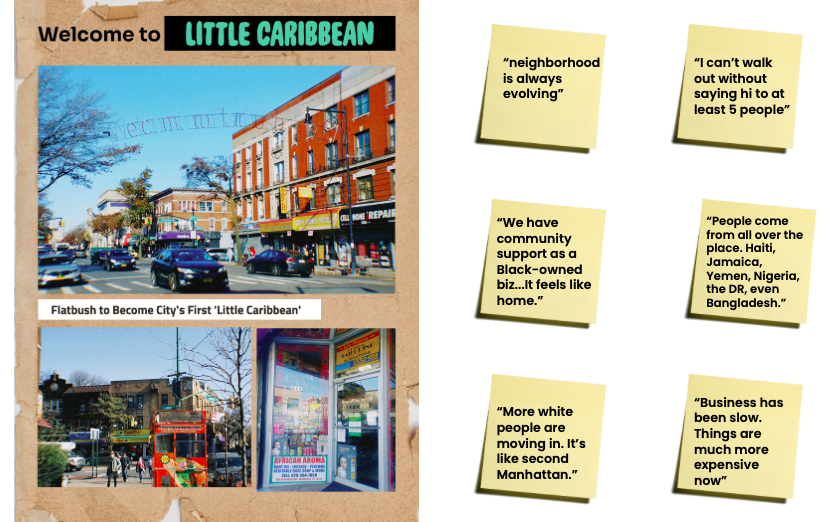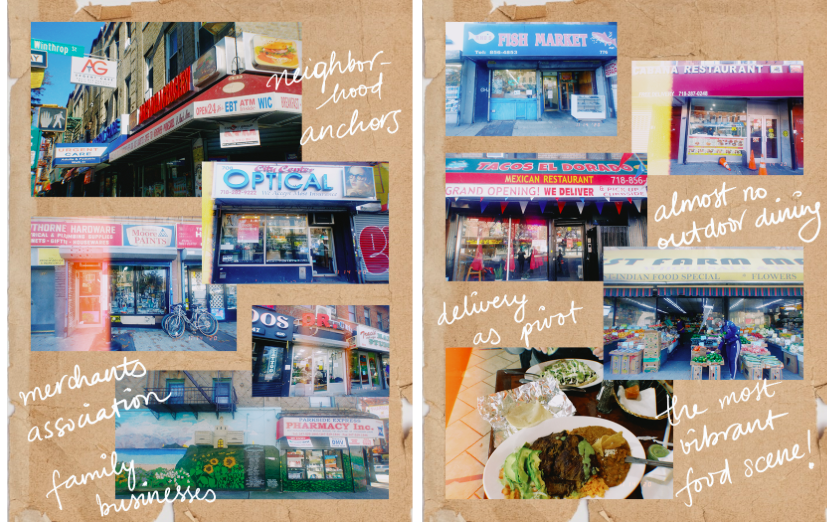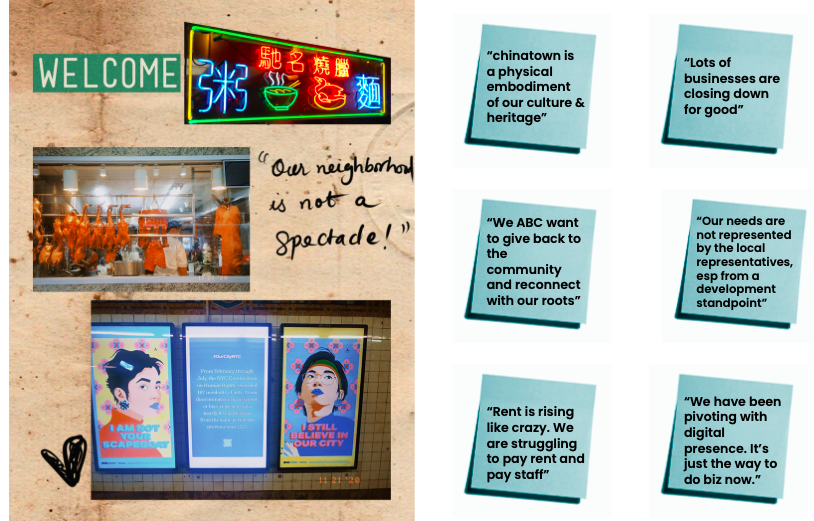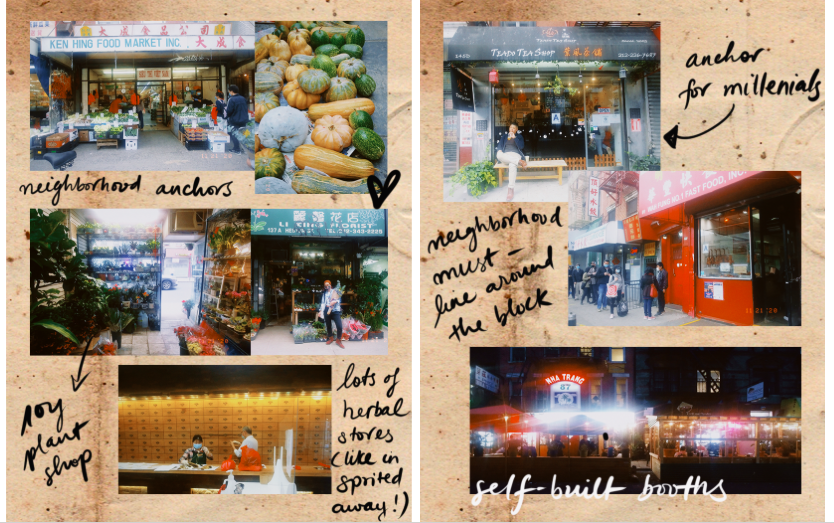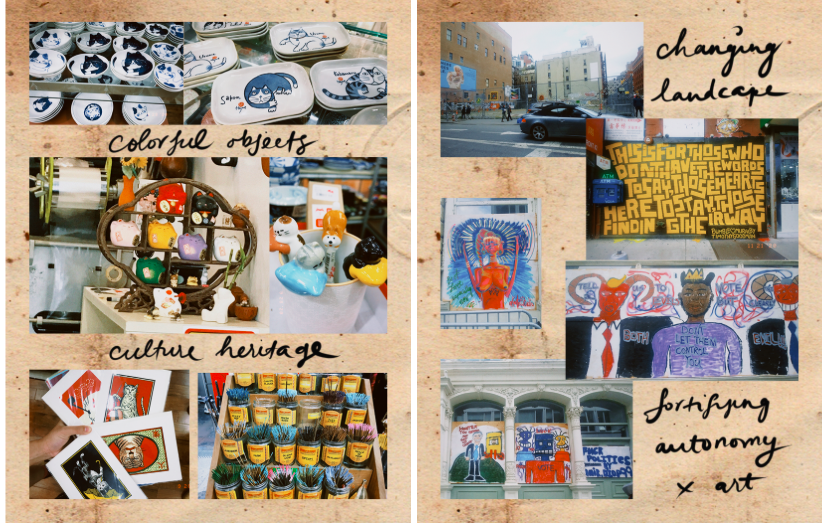When Immigrant-owned Small Businesses Meet Community Organizing
role: design researcher
RESEARCH DURATION: October-December 2020
Main methods I used:
+ Neighborhood mapping
+ Network analysis
+ Research synthesis
+ Ethnographic & field research
+ Neighborhood dérives
+ Urban design framework
Synthesis lenses:
+ Lived but not spoken
+ Different yet the same
+ Invisible Heroes
+ Culture as designer
+ New world, old world
+ Static vs. Dynamic
+ Looking in, looking out
+ Walking the talk
+ Talking the walk
+ Debunking myths
+ Hidden in plain sight
+ Intuitive vs. Logical
+ Power of anecdotes
Introduction
Dr. Cuts
Dr. Cuts is one of the neighborhood anchors of Little Caribbean, located on Flatbush Avenue, in a neighborhood that the New York Times called “a veritable mecca of beauty.”
The barber shop is owned by Desmond Romeo, who’s originally from Trinidad and has been cutting hair for people from the neighborhood for nearly 2 decades. Despite the challenges the pandemic has imposed on small, minority-owned businesses, Dr. Cuts and other hair salons and braiding shops nearby are bustling with trusted clients from the community.
When I visited the shop, Mr. Romeo told me about the Merchants Association that he founded to support local businesses. The Association consists of business owners from the neighborhood who are passionate about helping each other out, from applying for grants to marketing and seeking legal representations. During the conversation, Mr. Romeo was welcomed with many “hello’s” and “how are you doing’s” from passersby, adults and children alike.
Pearl River Mart
Pearl River Mart has been a beloved symbol of creativity and resilience in Chinatown LES. For over 45 years, the store has maintained their mission of promoting cultural exchange through commerce amidst the drastically changing landscape of Chinatown. The co-founder, Mrs. Ching Yeh Chen, told me about the continuous journey of Pearl River Mart adapting to the pandemic, the coming of big corps like Amazon, and the gentrification of her neighborhood.
“A lot of second-generation ABC (American Born Chinese) came back to Chinatown to help businesses here with their creativity and new ways of doing commerce,” she said. Her daughter in law, who is now the President of the company, built out their online presence and marketing strategies, while pivoting the business model to include more diverse products and partnerships with local artists and community organizations.
Like Dr. Cuts and Pearl River Mart, immigrant-owned small businesses (IOSB) around NYC are learning to adapt to the challenges of the global pandemic. Between February and April of 2020, more than 3 million small businesses closed down across the country, of which IOSB fell by 36%. To support these businesses, community organizers (CO) and local orgs have started a robust wave of support and solidarity, from fundraising to social practice art. The businesses themselves are also pivoting their businesses model to survive, and at the same time to help their harder hit communities.
Research Question
Inquiry: How does the global pandemic open doors for the collaboration of immigrant-owned small businesses and community organizing?
Purpose: How do we build a robust and connected relationship between IOSB & community organizing to foster neighborhood resiliency?
Research focus: Chinatown (Lower East Side) & Little Caribbean (Brooklyn).
Research Findings
Neighborhood Dérive Notes & Snapshots
Little Caribbean (LC) is a tight-knit community with a deep appreciation of heritage. The neighborhood is described by people in the community as “diverse,” “warm” and “always changing.” A lot of people here come from Haiti, Nigeria, The Dominican Republic, Jamaica, Bangladesh and Yemen. People say hi to each other on the streets and create a vibrant oasis of home.
Some snapshots from the dérive:
Neighborhood anchors: barber shops, hair salons, nail salons, bakeries, corner pharmacies, etc.
Dorsey Art Gallery, founded by Lawrence Peter Dorsey 30 years ago, is the oldest and continuously active black-owned gallery committed to celebrating the works of artists of color.
Local organizations like Little Caribbean, and multidisciplinary ventures like Caribbeing have promoted local products and cultural specialties from the neighborhood through partnerships with different brands, as well as participated in food tour and cultural events that bring LC to a broader audience.
Key Insights:
The fabric of the neighborhood is changing drastically; rent and cost of living are becoming more expensive.
There are mutual aid groups and local-run organizations supporting local businesses by driving sales and visibility, fundraising and advocacy.
Since the beginning of the pandemic, IOSB have been hit hard, especially essential services and restaurants. A lot of businesses pivot to e-commerce while others close down temporarily to permanently (resulting in empty storefronts).
There is a deep sense of community and cultural heritage in every corner.
Neighborhood Dérive Notes & Snapshots
At first glance, Chinatown LES is pretty much still vibrant and hustling with people coming in and out of the markets and other neighborhood anchors like plant stores, herbal stores and restaurants. Despite its resilient spirit, Chinatown LES is still struggling because of its heavy dependence on foot traffic and tourism, unlike other Chinatowns in Flushing and Sunset Park.
A lot of businesses who have been neighborhood anchors for 10-30 years are closing down for good. Local organizations and community organizers have been raising funds and promoted small businesses so that they can pay rent, pay staff and maintain regular business. Organizations like Think!Chinatown collaborated with architects and designers to build beautiful outdoor dining booths for restaurants, while others like Send Chinatown Love and Welcome to Chinatown help with business strategies, outreach, translation, and digital presence.
Asian immigrants and Asian-Americans are proud of Chinatown, because it is the physical embodiment of their culture and heritage. The pandemic has allowed for the surge of anti-Asian discrimination on people of Asian descent. In Chinatowns around the U.S., local businesses are hit hard while many Asian seniors suffer from harassment.
“Our neighborhood is not a spectacle” is a statement that many young American-born Asians shared with me when mentioning what has been happening in their community. There have been people coming to the neighborhood attempting to “help” local businesses, yet in the end did not actually drive sales or positive impact to these businesses.
Organizers and volunteers have works really hard to bring Chinatown stories and voices to the forefront, not only for media representation, but also for changing mindsets.
Key Insights
Businesses are struggling because they depend heavily on foot traffic and tourism.
Second generations are coming together with older generations to defend and represent their roots in both business and culture.
Community organizations are helping businesses improve their digital presence and build new revenue streams.
Common Themes between 2 neighborhoods
1. Gentrification and Displacement:
In 2018, 33.2% of renter households in East Flatbush were severely rent burdened (NYU Furman). In Manhattan’s Chinatown, the median rent was $1140 in 2017. Lower East Side was #12 citywide on the Index of Housing Price Appreciation. The median rent was $810 in 200 (NYU Furman Report 2019).
Between 2000 and 2010, Little Caribbean and its encompassing neighborhoods (Crown Heights, Flatbush and Prospect Lefferts Gardens), each lost from 10 to 14% of their Black populations. The West Indian immigrants and African-Americans who have made their homes for generations in this Brooklyn neighborhood are “scattering, muscled out by surging rents and (…) landlords who harass tenants, withhold repairs or use evictions to make room for higher-income renters.” Likewise, IOSB in this community are struggling to pay rent, pay staff, and keep up with business-related costs while fearing displacement looming at the horizon.
Like LC, Chinatown is also grappling with gentrification and displacement. According to a restaurant owner I spoke to, the rent is raising 10% every year, with landlords being not so flexible. 7 out of 10 restaurants on the same block he knows have closed down because they can’t keep up with rent and paying staff. Another business owner told me that their biggest challenge is to "keep the wok, release pots and pans,” or in other words, keep the essence while significantly reduce the size of the business.
Apparently, the community does not feel represented by the local representatives when it comes to the development agenda. “They always report that everything is going great and going fine but in fact people are struggling to be seen and heard,” said an interview respondent.
2. Resources and Funding:
Mutual aid groups and local organizations have raised funds to deliver certain impacts to the community:
To help businesses survive, build out dining capacities and thrive in the long run
To support local cultural preservation and cultural promotion
To raise awareness about the issues people face in each neighborhood
To drive media outreach and community support
3. Opportunities:
Creative Intervention can drive visibility to the otherwise hidden stories in each neighborhood. Creativity can be harnessed to tell authentic stories, build supportive infrastructures and initiatives, connect people across the diaspora, preserve and promote cultures, and create a sense of community.
Storytelling can come in different ways (social practice art, video & animation, exhibitions & performances, articles, etc.). Some existing examples that highlight the cross pollination of ideas and interdisciplinary collaboration of stakeholders include Everyday Chinatown from Think!Chinatown, Coronavirus: Chinatown Stories by Grace Young, and the Chinatown Mural Project by Peach Tao.
Community Outreach can build trust with community members, leverage networks to support local businesses, and create connections across borders and boundaries. Community outreach can include fundraising campaigns, partnerships with local organizations, promotional events such as food tours, and creative collaborations with organizations, agencies, brands, and creatives.
Business Strategy Collaboration across cultures, generations, and disciplines can help small businesses thrive. Some ideas include:
Incentives (coupons, discounts or punch cards)
Building capacities to respond to COVID-19 (outdoor dining, contact tracing, temperature checks, online resource center, etc.)
Marketing strategies (participating in food tours, promoting businesses on the map / business ecosystem, local business highlights)
Improving business models (diversify revenue streams, partnership with brands, online shopping and delivery)
Improving digital presence (local map of hidden gems, business online directory, websites)
Partnering with local merchant associations (help applying for grants and investments, seek legal representation, organize local events)
Investing in leadership and staff (diversity & inclusion, training for agility and resilience, from reactive to proactive)
Moving Forward
The global pandemic has pushed us to rethink how cities and local communities that can thrive across physical and cultural boundaries. This research project has shown stories of the two neighborhoods in New York City that teach us a lot about agility, adaptability and resiliency.
Moving forward, it is critical to continue supporting the collaboration between immigrant-owned small businesses and community organizing, because it is a powerful avenue to drive local economy, cultural heritage, and community well-being for generations to come.
Special Thanks
My instructor Adriana Young & studio classmates at Parsons School of Design
Luis Marin, Dérive Partner & Photographer
Marcia Hu, Send Chinatown Love
Gabby Tran, Welcome to Chinatown
Shelley Worrell, CaribBEING
Cindy Trinh, photojournalist & social activist
Desmond Romeo, Dr. Cuts & Flatbush Avenue Merchants Association
Ching Yeh Chen, Pearl River Mart
Nga Than, The Graduate Center, CUNY
Vinay Kumar Mysore, Openbox
Design Inspiration
Culture EX: arts & culture-focused digital experience to bring alive stories from NYC neighborhood

